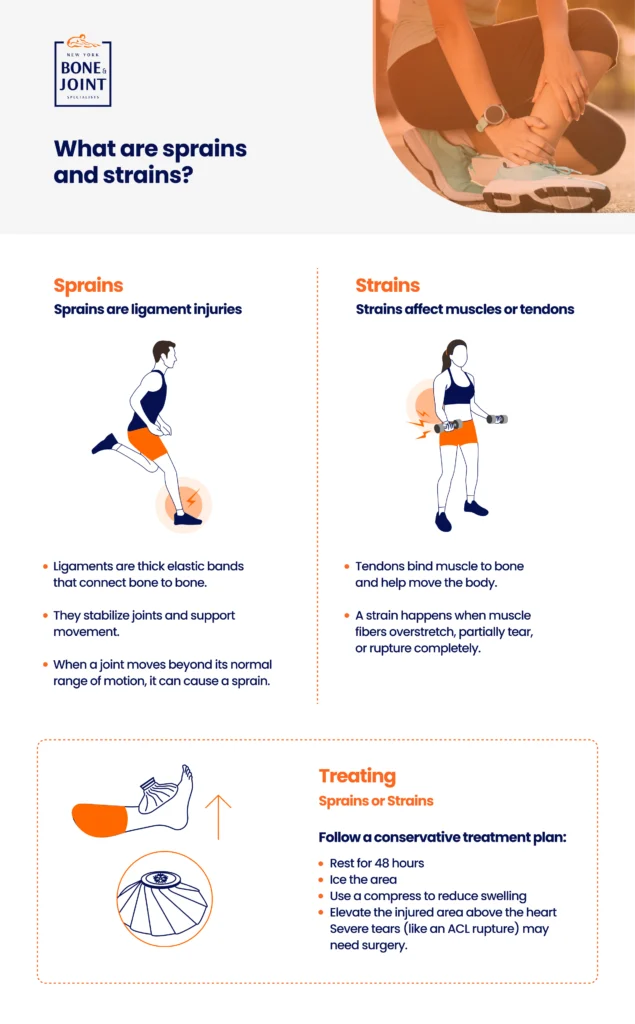Dealing with a sprain or strain in New York? You’re not alone. These common orthopedic injuries affect millions of Americans annually, with ankle sprains alone sending over 2 million people to emergency rooms each year. At New York Bone & Joint Specialists, our experienced orthopedic doctors provide expert diagnosis and treatment for all types of sprains and strains, helping you get back to your active lifestyle quickly and safely.
Whether you’ve twisted your ankle on a NYC sidewalk, strained your back at work, or suffered a sports-related injury, our team of specialists is here to help. With locations throughout New York, expert care is always within reach.
Sprains vs Strains: What’s the difference?
What is a Sprain?
A sprain occurs when ligaments—the tough, fibrous tissues that connect bone to bone—are stretched beyond their normal range or torn. Sprains most commonly affect:
- Ankles (the most frequent type of sprain)
- Knees
- Wrists
- Thumbs
Sprain symptoms include:
- Sharp, throbbing pain
- Swelling and bruising
- Limited range of motion
- A “popping” sound at the time of injury
- Joint instability
EXPERT DOCTOR QUOTE
What is a Strain?
A strain happens when muscles or tendons—the tissues that connect muscles to bones—are overstretched or torn. Strains frequently occur in:
- Lower back
- Neck
- Hamstring muscles (back of the thigh)
- Calf muscles
Strain symptoms include:
- Muscle pain and tenderness
- Swelling
- Muscle spasms
- Difficulty moving the affected area
- Weakness in the muscle
How to tell the difference between a sprained ankle vs. broken ankle
A doctor at New York Bone & Joint Specialists will perform a physical exam of the affected joint and ask you when and how the pain began. He or she may do imaging tests to rule out other conditions, such as a broken bone. Yet you can tell the difference between an ankle sprains vs broken ankle by these telltale signs:
- A cracking sound was heard when the injury occurred.
- The ankle appears misshapen.
- The bony part of the ankle is tender and painful to the touch. (With a sprain, the soft tissue will be tender to the touch.)
- The toes feel numb.
If you think you’ve fractured one of the three bones in your ankle, seek medical attention immediately. It will need to be put in a cast.
The difference between sprains and strains
Our orthopedic specialists classify sprains and strains into three grades based on severity:
- Grade 1 (Mild): Slight stretching with minor microscopic tears. Minimal pain and swelling, with little to no loss of function.
- Grade 2 (Moderate): Partial tearing of the ligament, muscle, or tendon. Moderate pain, swelling, and some loss of function.
- Grade 3 (Severe): Complete rupture of the tissue. Significant pain, swelling, and complete loss of function. May require surgical intervention.

Let’s review some common sprains and their symptoms:
Ankle Sprains
Ankle sprains occur when the ligaments supporting your ankle joint are stretched or torn, typically from rolling or twisting your foot. This can happen during sports, walking on uneven surfaces, or even stepping off a curb wrong. You’ll know when to go to the doctor for a sprained ankle if you experience severe pain, notice significant and rapid swelling, or if it cannot bear weight.
Signs of an ankle sprain:
- Immediate pain and swelling
- Difficulty bearing weight
- Bruising around the ankle
- Joint instability
Sprained Thumb
Thumb sprains often result from trying to break a fall with an outstretched hand or from sports activities involving catching or gripping.
Symptoms include:
- Pain and tenderness at the base of the thumb
- Swelling and bruising
- Difficulty gripping or pinching
- Limited thumb movement
Knee Sprains
Knee sprains can range from minor to severe, with ACL (anterior cruciate ligament) tears being among the most serious. These often occur during sports involving sudden stops, jumps, or direction changes.
Warning signs:
- Loud “pop” sound during injury
- Severe pain and rapid swelling
- Inability to bear weight
- Feeling of instability
Sprained Wrist
Wrist sprains commonly result from falls, sports injuries, or car accidents. With 20 ligaments supporting eight wrist bones, various injury patterns can occur.
Symptoms include:
- Pain that worsens with movement
- Swelling and tenderness
- Bruising
- Difficulty using the hand
Back and Neck Strains
Muscle strains in the back and neck often result from lifting heavy objects, sudden movements, or poor posture over time.
Common symptoms:
- Muscle pain and stiffness
- Spasms
- Limited range of motion
- Pain that radiates to other areas
“While sprains and strains are common injuries, proper treatment is crucial to prevent them from becoming chronic problems that limit your activities. Our sports medicine expertise will help you heal completely and return to your normal routine stronger than before.” – Dr. Leon Popovitz, MD, Co-Founder of New York Bone & Joint.
How do our specialists treat sprained ankles and other strains?
Our sprained ankle and sprained wrist specialists take a conservative approach to treating sprains and strains, which centers on the RICE method. This therapy can be done at home after consulting with one of our physicians.
- Rest: Avoid activities that cause pain for 48-72 hours
- Ice: Apply for 15-20 minutes every 2-3 hours for the first 48 hours
- Compression: Use elastic bandages to reduce swelling
- Elevation: Keep the injured area raised above heart level when possible
Other treatments may include:
Medication Management
- Anti-inflammatory medications (ibuprofen, naproxen) to reduce pain and swelling
- Acetaminophen for pain relief
- Prescription pain medication for severe injuries when appropriate
Supportive Devices
- Braces, splints, or walking boots for stability
- Crutches to avoid weight-bearing
- Compression garments for ongoing support
Physical Therapy
Our rehabilitation specialists design customized programs to:
- Restore range of motion
- Rebuild strength and stability
- Improve balance and coordination
- Prevent re-injury
Over 90% of our patients recover without surgery through our comprehensive conservative treatment approach.
Why are we among the best New York sprains and strains doctors?
New York Bone and Joint Specialists: Your trusted partner for sprain and strain treatment in the Big Apple for decades. Why choose us?
- Prioritizing Your Mobility: We are dedicated to the preservation and healing of your muscles, ligaments, and tendons, crucial for a long, healthy, and active life.
- World-Class Compassionate Care: Our joint specialists provide comprehensive care, guiding you from diagnosis through recovery for a variety of conditions.
- Minimally Invasive Solutions: Over 90% of our orthopedic cases are successfully resolved without surgery.
- Complete Recovery: We offer complete recovery for every patient through conservative treatments and, when necessary, expert surgical interventions.
Our best-rated sprains and strains specialists in NYC
New York Bone & Joint Specialists prioritizes patient well-being through a dedicated care team of physicians, surgeons, physical therapists, and support staff. We are committed to delivering outstanding care and reassurance to each patient, ensuring the long-term health and function of their vital muscles, ligaments, and tendons..
Supported by extensive accreditations, publications, and knowledge, our sprain and strain doctors are nationally recognized.
Make an appointment today
Start your recovery today. Book your appointment with New York Bone & Joint Specialists now.
Sprains & Strains Doctors: FAQs
Should I see a doctor for a sprained ankle?
If you experience severe pain, cannot bear weight, or notice significant swelling and instability, you should see a doctor promptly. Even for milder sprains, professional evaluation ensures proper diagnosis and treatment guidance.
How long does a sprained ankle take to heal?
Recovery time varies by severity:
- Grade 1 sprains: 1-3 weeks
- Grade 2 sprains: 3-6 weeks
- Grade 3 sprains: Several months with possible surgery
Proper treatment and rehabilitation are crucial for optimal healing.
What’s the difference between a sprained ankle and a broken ankle?
Key differences include:
- Broken ankle: Often involves a cracking sound, visible deformity, inability to move the ankle, and severe tenderness over the bone
- Sprained ankle: Usually involves soft tissue pain, some ability to move (though painful), and tenderness around the joint rather than over bone
Will I need surgery for my sprain or strain?
Surgery is rarely needed for sprains and strains. Most patients recover fully with conservative treatment. Surgery may be considered for:
- Complete ligament or tendon ruptures
- Injuries that don’t respond to conservative treatment
- Recurrent injuries affecting daily activities
Which heals faster: sprains or strains?
Generally, muscle strains heal faster (2-6 weeks) due to better blood supply. Ligament sprains take longer (3 weeks to 6 months) as ligaments have limited blood flow. However, individual healing varies based on injury severity, age, and overall health.



